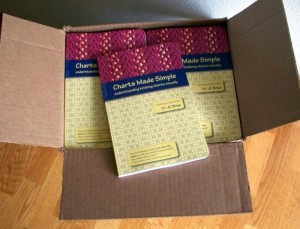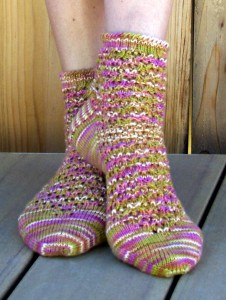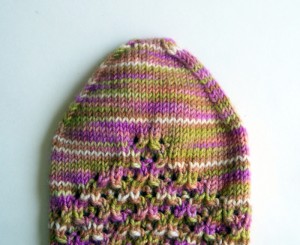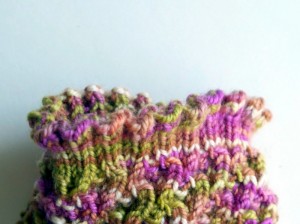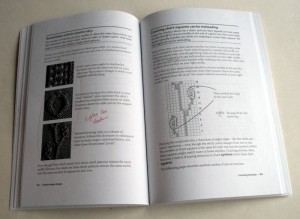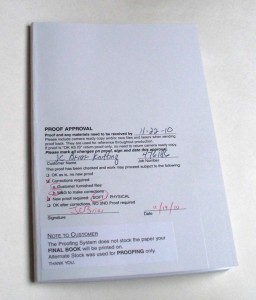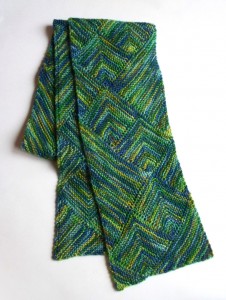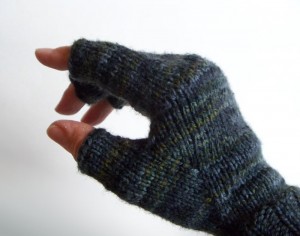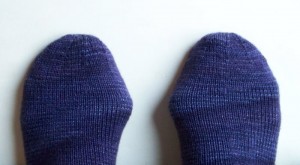At long last, Charts Made Simple is now available for order through Amazon.
Does that mean the book is “real”? More real than when it wasn’t available through Amazon?
Some people may think so. Myself, I’m waiting for the book to be available at Powell’s. Or at any yarn shop I happen to pop my head into. That’s right, folks: I’m aiming for ubiquity.
When most knitting books go on the road, they go in the form of a trunk show: garments featured in the book are packed up, shipped to a yarn shop, and displayed prominently. Knitters get to see and feel the garments, and sometimes try them on. The books get a kick out of all the oohs and aahs.
Charts Made Simple isn’t that kind of book. It doesn’t have any garment patterns. It won’t have any trunk shows. It’s kind of like the kid whose birthday party was canceled because her brother got the chicken pox. (No, I don’t hold a grudge; why do you ask?)
How to console Charts Made Simple over the lack of trunk shows? By combining book signings with a Stump the Chart Wizard challenge.
Saturday, February 5, I’ll be at Fiber Nooks and Crannys from 1-3pm for my very first book signing. C’mon down, and check the book out. Better yet, bring a chart that’s been puzzling you, and see how the concepts in Charts Made Simple clear away the confusion. Let Charts Made Simple prove its mettle.
More book signings are sure to come! The current game plan is to have one at Stitches West, at the Yarn Barn booth at 5pm on Friday, February 18. We can play Stump the Chart Wizard there too. Books will be available at the Yarn Barn, of course, and also at Village Spinning and Weaving and Blue Moon Fiber Arts.
All morning, I kept listening for the tell-tale drone of the UPS truck. False alarms made me all jittery, then crushed my spirit. Finally, mid-day, these arrived:
Books! Not a mere idea, not a bunch of InDesign files, but real, live, don’t-stub-your-toe-on-the-boxes books! Charts Made Simple was so long in the making, I wasn’t sure I’d ever see this day.
Still, it took a few moments to screw up the courage to actually open one of the books. What if I immediately found errors? What if I didn’t like what I saw?
Nope. I like them. I like the feel of the paper. I like the way the fonts look, all nice and sharp on the top-notch paper. I like the rounded corners, and the sturdy binding—I suspect the books will hold up well, even when jostled around in knitting bags.
Now, to start shipping books. Soon enough, they ought to be in yarn shops around the country. And when online ordering becomes a reality, I’ll announce it here on the blog.
Eventually, someday, I might even find the courage to sit down and read the book myself.
Sock news
By JC | January 6, 2011
Sock Summit 2011 is approaching fast, and nobody knows it better than ST-1. Among a million other tasks, they’ve got to figure out who will teach what during four sock-filled days. Imagine: dozens of teachers, umpteen three- and one-hour time slots, untold numbers of tantalizing topics. The mind boggles at the thought of spreadsheets bursting at the seams, and sticky notes threatening to take over dining room tables.
So far, I don’t know who all is teaching, and I don’t know exactly what my schedule will be. But it’s likely I’ll be teaching a handful of favorite classes. (Really, how could we not offer Cast-on Cornucopia?) And I’ll probably be teaching a couple new classes.
That’s where you all come in.
I have tentative titles for the two new classes: Writing Sock Patterns and Socktastic Stitch Patterns. I have an idea of what I’d like to cover in each class. But—here’s the thing—if you were taking these classes, what would you want them to cover?
Here’s how I figure it: Writing Sock Patterns would not be a sock design class. (That’s non-negotiable.) Rather than “how to come up with a great sock design,” the class would cover “how to get a great sock design down on paper.” That is, once you’ve figured out the winning mix of construction, stitch pattern, and stitch counts, how do you write it all down such that someone else can make it happen?
Well, okay, this wouldn’t be a brand-new class, really. I’ve yakked on about pattern writing before, stressing the goals to keep in mind and the value of style guides. And I’ve certainly edited enough sock patterns, so I think I have a clue as to the particular pitfalls to avoid when writing a sock pattern.
But, again, if you were taking the class, what would you want it to cover? On a related note: Why would you take this class? Would you hope to sell sock patterns to magazines and yarn companies, or start your own pattern line, or …? Tell me where you’re coming from, so I can meet you in the middle.
As for Socktastic Stitch Patterns, I figure it’d be fun to talk about tweaking stitch patterns: combining them to make interesting rib patterns; making a pattern’s repeat wider or narrower; planning the “flow” between a sock’s cuff, leg, heel, and toe. Skills like these make it possible to gussy up a basic sock pattern, to fine-tune the sizing of a sock, and to finesse a new design.
Sound good to you? Sounds kind of broad and unfocused to me. If you signed up for this class, where would you want the focus to be? What aspect of tweaking stitch patterns for socks really rings your bell?
One last bit of sock news: Yachats is now available on Patternfish. Get your copy now, and you have time to knit up a pair before spring break. 🙂
In the past few weeks I haven’t been doing any teaching. (With good reason! Who wants to take a knitting class during the holiday season?) But that doesn’t mean I’ve been twiddling my thumbs. December is prime time for teachers like myself and event organizers to get together and plan the coming year. The result? These new gigs have just been added to my schedule:
- Fans of the Loopy Ewe’s Spring Fling have probably already heard that I’ll be teaching there in April, along with Anne Hansen, Kirsten Kapur, and Laura Nelkin. I’m looking forward to it: with a Dessert Reception and multiple knitting lounges, how can it not be fun?
- Black Sheep Gathering! Ah, the fiber festival that’s in my backyard… well, less than an hour from my backyard, anyway. I love so much about it: catching up with friends; prowling the vendor floor; visiting the alpacas, bunnies, goats, and sheep in the animal barns; and listening in on the fleece judging. (Even though I don’t spin! The fleece judging is that educational.)
- This year’s TKGA/CGOA Fall Knit & Crochet Show will be in Greensboro, NC. I haven’t spent any time in North Carolina, and I don’t associate it with “the South,” but maybe I’m wrong: while making hotel reservations a little bit ago, I spoke with a woman with the sweetest Southern drawl. Will we get the full Southern hospitality treatment? Complete with sweet iced tea?
More events are in the works! My complete schedule, as always, is here. To find out when sign-ups begin for an event, visit that event’s website or contact its organizers.
The other day I saw a demonstration of bobbin lace. Sheesh, did that lacemaker make those bobbins fly! I have no clue how she could move so fast, yet remember where she was in the pattern.
But even though I’m curious as to how bobbin lace works, even though I’m a skill junkie that likes to collect skills like other people collect stamps or Kewpie dolls, I don’t see myself picking up bobbin lace. Tatting, maybe someday, just for yuks. Weaving, definitely, one of these days. But bobbin lace? Nah, no thanks. Too fiddly for me.
I had the best time today writing up the pattern for a scarf I plan to knit.
This is odd. Most designers (myself included) would say that pattern-writing isn’t their favorite task. Rather, it rates far below sketching or swatching, and somewhere near envelope-stuffing.
Apparently, though, it’s been long enough since I last wrote or tech-edited any patterns that pattern-writing now counts as a fun change of pace. Of course, I enjoyed drawing a bunch of charts. Some will actually go in the pattern; some just helped me see what the pattern needs to say. But I actually enjoyed writing the pattern too: figuring out a clear and yet reasonably concise way to get the message across.
Wanna sneak peek?
The yarn is Berroco Ultra Alpaca Fine. I fell in love with the stuff when I knit Jolie, and bought more with the idea of swatching for a sweater… but wound up designing a scarf instead. (These things happen.)
This is just a swatch, of course. The real scarf will have the same pointed ends, but it’ll be substantially longer and a tad wider. And it’ll have some short-row shaping to create a gentle crescent curve. I’m picturing the final result as long, drapey, frilled a bit on one edge, and perhaps with a tiny corkscrew effect from the short rows. Or maybe a big corkscrew effect. It depends on how many short rows I decide to throw in. After all, I can re-write parts of the pattern if I want.
Who woulda thunk pattern writing could be so much fun?
Limbo
By JC | November 23, 2010
With Charts Made Simple in the printer’s hands, I’m kind of at loose ends. Tasks that had been sucking up gobs of time are now completed, but I’m not ready to start anything new. Just the thought of beginning a large project—book or otherwise—gives me the heebie-jeebies at the moment.
So instead I’m looking to tie up loose ends. One of them is Corrine.
Loose ends indeed. I designed these socks a year (or more?) ago, knit them mid-summer, had them tech-edited in September… and only just now made the pattern available through Patternfish.
Don’t think for a minute, though, that dragging my heels on this project means I don’t love these socks, because I do love them. It’s the stitch pattern that really turns my crank.
Named Clematis, I found it while leafing through an obscure stitch dictionary. Bits of ribbing mix with decreases that sway in and out. Yarn overs keep the stitch count constant, but don’t take center stage. The resulting honeycomb fabric has an incredible squooshy, sproingy feel. I was excited by the find—I knew immediately Clematis was perfect for socks.
(Ironically, a couple weeks later I found the same stitch pattern in Barbara Walker’s A Treasury of Knitting Patterns, under the name Hourglass Eyelet Pattern. I’ve pored through that book a million times. Why didn’t I ever notice the stitch pattern there?? Go figure.)
For fun, I wrote the pattern with a choice of two cuff treatments.
The ruffled cuff makes use of one of my favorite sock-knitting tricks, courtesy Lucy Neatby’s Cool Socks, Warm Feet: for a totally non-restrictive cast-on edge, cast on twice the number of stitches you need; after a round or two, decrease down to the “real” stitch count. Of course, you can go nuts and cast on four times the stitches you need, and gradually decrease over a few rounds—that’ll give a more pronounced ruffle. But I like the subtle ruffle you see with the Corrine sample above.
The second cuff option, the knotted cuff, makes use of the Channel Islands cast-on. If you ask me, it’s a totally underrated cast-on: attractive, supremely sproingy, and fun to do. More knitters ought to know it—which is why I included complete instructions in the pattern. The effect here is of soft knots, almost like reverse single crochet.
sigh. I wonder what other little things I might get done, while in limbo between big projects.
This morning, FedEx dropped off a long-awaited package: print proofs for Charts Made Simple. The color cover was separate from the interior, and the interior had been printed on lighter-weight paper than will be used for the actual book. But the proofs were bound. It’s starting to look like a real book.
So I spent a good chunk of the day poring over the proofs, pinpointing areas that need improvement. Fortunately, there aren’t too many. Photos need to be lightened a bit, despite looking fine on my monitor and when printed on my cheap desktop printer. (No surprise there, really.) And a few illustrations need to be tweaked. But overall, it’s almost good to go.
FO parade
By JC | November 18, 2010
A couple weeks ago, after realizing I had a few too many WIPs sitting around, I took action. First, I finished this:
This scarf had been done for months, except for weaving in the ends and blocking—finishing it off was low-hanging fruit indeed. Knit out of Pico Accuardi’s sock yarn in a stunning Acid & Weed colorway, it’s destined to serve as another sample for my Multi-directional Scarves class.
Next, I finished a second pair of fingerless gloves:
Much as I love the first pair, I love the fit on these even more. Working six short rows across the knuckles makes the glove hand curl around my hand perfectly, with no excess fabric bunching in the palm. And I like having the gusset increases angle around the base of the thumb. Too sweet! These gloves will reside in the pockets of a warm black jacket, while the previous pair have already taken up residence in the pockets of a bright blue rain jacket.
Most recently, I finished these:
Sorry, I can’t show you the whole socks. The pattern has been sold but not published, so I have to keep the juicy bits under wraps. (The foldover cuffs are to die for. Trust me.) Anyway, I didn’t knit the toes according to pattern. Instead, I knit round toes, which are rapidly becoming my favorite kind of toe. They fit my oddly shaped feet surprisingly well, don’t you think?
Oh, and the yarn? It’s Prism Saki, in Plum Dandy. Nice stuff! I like its subtle pooling. Then again, I usually like pooling in my socks—some knitters can’t stand it, but I like the serendipity.
Lastly, you may have noticed I just finished overhauling my website. Mostly, it was an under-the-hood reorganization: putting everything under WordPress control made it easy to have this blog and the rest of the site resemble each other, and made is possible to add a search page that works for the entire site.
But I’ve also added a page for Charts Made Simple, which ought to hit yarn stores in about a month and a half. Whee! I can’t wait. 🙂




